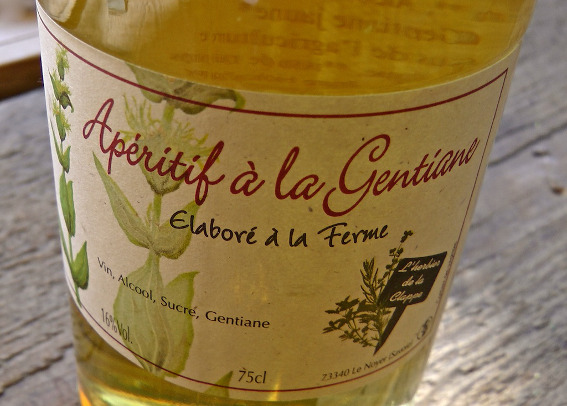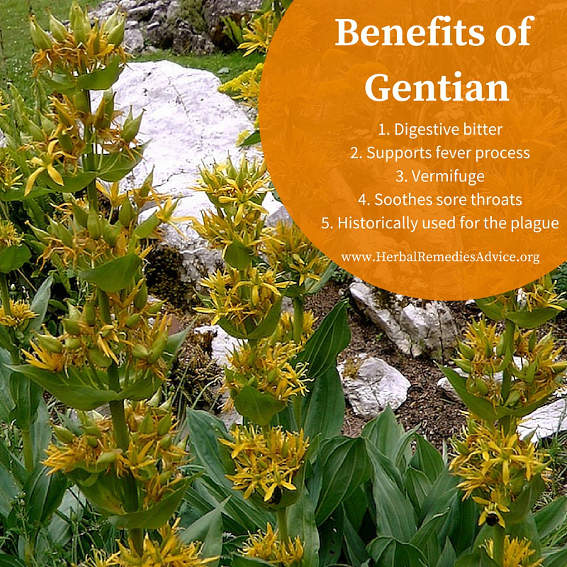Get weekly tips, recipes, and my Herbal Jumpstart e-course! Sign up for free today.

Gentian Herb
Share this! |
|
Gentian Herb
Yellow
gentian herb (Gentiana lutea) from the French Alps is world renowned for its
healing abilities. It has been used as medicine in Europe for 2200
years.
We first saw this plant growing high in the French Alps in a meadow filled with dandelions and buttercups. My husband’s father pointed it out to us and, partly because he had misidentified a few plants already, I was sure he was mistaken. The non-flowering plant highly resembles false hellebore (Veratrum viride), a plant that demands respect and caution!
But sure enough, this tall beauty was indeed the highly revered local gentian. We found it growing throughout mountain sides in France. Later in the trip we found it growing on a volcano in central France.
This
is a perennial herbaceous plant that grows up to two meters tall. It
flowers after about three years and the roots are harvested for medicine
after it is five to ten years old.
Because yellow gentian from France is especially revered for medicine, it has unfortunately been over-harvested. France has it designated as an endangered plant and it is illegal to harvest it unless you have a special permit. Mountain Rose Herbs carries gentian root from a cultivated source in France that is very high quality. I’ve been using this myself for the past year in my digestive blends.
Gentian root is bitter, bitter, bitter. Its actions are cooling and drying. (For more information on how herbalists use the sense of taste, you may be interested in my Taste of Herbs course)
It is most famously used as a bitter digestive tonic and is frequently made into an aperitif, which is a before dinner drink that increases the appetite. This can be especially useful before eating a rich and fatty meal, which, of course, the French are famous for! After our visit to this beautiful meadow, Xavier’s father took us bar hopping - herbalist style. We tried several different digestifs and aperitifs featuring local bitter plants, gentian among them.
Gentian is an ingredient in angostura bitters, stockton bitters and vermouth. While traveling around the Alps in France we found numerous small companies that made an aperitif from gentian. Before the introduction of hops it was used as a bitter flavoring for making beer in Germany and Switzerland

Gentian Uses
As a cooling bitter it has other uses as well.
It’s used as a antipyretic during high fevers. King Gentius of Illyria, who lived from 180-67 BCE, is said to have discovered gentian herb as medicine after this plant cured his army of a mysterious fever and today the plant continues to carry his name.
This strong bitter is also used as a vermifuge, to expel worms or parasites from the body.
In the mid 1800’s gentian was mixed with licorice as a remedy to quit smoking.
Nicholas Culpepper wrote in the mid 18th century that it was a sure remedy for the plague, but I haven’t had the opportunity to try that out yet.
Gentian Herb Recipe
Maude Grieve recommends the following recipe as a stomach tonic to restore appetite and improve digestion:
- 2 oz. of gentian root,
- 1 oz. of dried orange peel,
- 1/2 oz. of bruised cardamom seeds,
- a quart of brandy
Infuse for four weeks, strain and use in small doses.
You
can buy the ingredients for this recipe at Mountain Rose Herbs, which helps to support the writings on this website -
thank you!
Do you use yellow gentian? I’d love to hear how you are using this or other bioregional gentians.

Rosalee is an herbalist and author of the bestselling book Alchemy of Herbs: Transform Everyday Ingredients Into Foods & Remedies That Healand co-author of the bestselling book Wild Remedies: How to Forage Healing Foods and Craft Your Own Herbal Medicine. She's a registered herbalist with the American Herbalist Guild and has taught thousands of students through her online courses. Read about how Rosalee went from having a terminal illness to being a bestselling author in her full story here.
